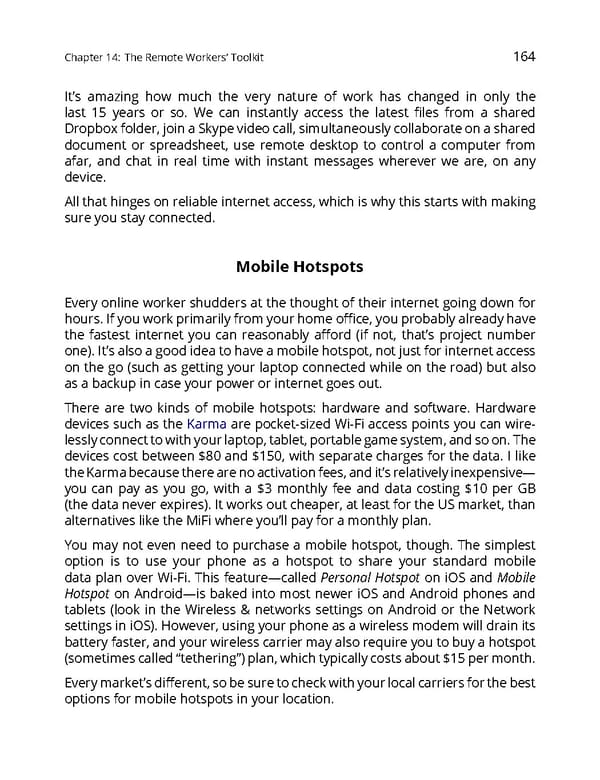Chapter14: TheRemoteWorkers’Toolkit 164 It’s amazing how much the very nature of work has changed in only the last 15 years or so. We can instantly access the latest files from a shared Dropboxfolder,joinaSkypevideocall,simultaneouslycollaborateonashared document or spreadsheet, use remote desktop to control a computer from afar, and chat in real time with instant messages wherever we are, on any device. All that hinges on reliable internet access, which is why this starts with making sure you stay connected. MobileHotspots Every online worker shudders at the thought of their internet going down for hours.Ifyouworkprimarilyfromyourhomeoffice,youprobablyalreadyhave the fastest internet you can reasonably afford (if not, that’s project number one). It’s also a good idea to have a mobile hotspot, not just for internet access on the go (such as getting your laptop connected while on the road) but also as a backup in case your power or internet goes out. There are two kinds of mobile hotspots: hardware and software. Hardware devices such as the Karma are pocket -sized Wi- Fi access points you can wire- lesslyconnecttowithyourlaptop,tablet,portablegamesystem,andsoon.The devices cost between $80 and $150, with separate charges for the data. I like theKarmabecausetherearenoactivationfees,andit’srelativelyinexpensive— you can pay as you go, with a $3 monthly fee and data costing $10 per GB (the data never expires). It works out cheaper, at least for the US market, than alternatives like the MiFi where you’ll pay for a monthly plan. You may not even need to purchase a mobile hotspot, though. The simplest option is to use your phone as a hotspot to share your standard mobile data plan over Wi-Fi. This feature—called Personal Hotspot on iOS and Mobile Hotspot on Android—is baked into most newer iOS and Android phones and tablets (look in the Wireless & networks settings on Android or the Network settings in iOS). However, using your phone as a wireless modem will drain its battery faster, and your wireless carrier may also require you to buy a hotspot (sometimescalled“tethering”)plan,whichtypicallycostsabout$15permonth. Everymarket’sdifferent,sobesuretocheckwithyourlocalcarriersforthebest options for mobile hotspots in your location.
 The Ultimate Guide to Remote Work Page 167 Page 169
The Ultimate Guide to Remote Work Page 167 Page 169